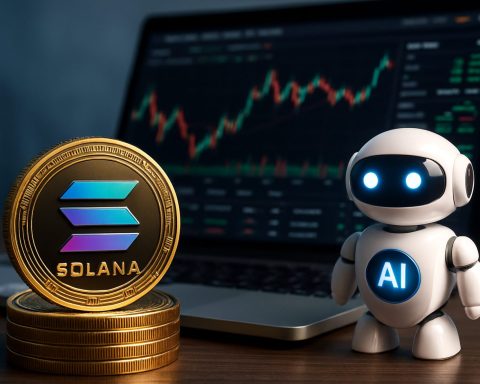- Nvidia faces challenges due to U.S. trade policies and export restrictions, impacting its AI chip sales to China, a crucial market for its growth.
- These restrictions could affect Nvidia’s earnings, as China plays a significant role in its data center revenue.
- CEO Jensen Huang demonstrates strategic leadership, maneuvering through difficulties by adapting Nvidia’s technology and investments.
- Huang’s negotiation efforts in Beijing aim to protect Nvidia’s interests, but outcomes ultimately hinge on government decisions.
- The situation highlights the interconnectedness of politics and technology, with Nvidia’s innovative spirit and market position offering potential for overcoming challenges.
- Nvidia’s resilience underscores the role of innovation in navigating and triumphing over adversities in the tech landscape.
Navigating through stormy seas often demands a deft hand at the helm. For Nvidia, a titan in the world of artificial intelligence (AI) chip manufacturing, the recent tempest swirling around trade tariffs and export regulations poses a formidable challenge. Once basking in the glory of soaring stock prices, Nvidia now finds itself embroiled in a complex standoff involving U.S. trade policies and export restrictions to China, testing the company’s resilience and innovation acumen.
The Silicon Valley powerhouse, known for pioneering graphics processing units (GPUs) that have revolutionized AI platforms, has seen its trajectory complicated by geopolitical dynamics. The U.S. government’s licensing requirements on the export of its H30 chips to China throw a wrench in Nvidia’s growth engine just as technology stocks reel from broader market downturns and tariff anxieties. This setback could significantly weigh on Nvidia’s earnings, as China constitutes a substantial chunk of its data center revenue.
Despite these headwinds, Nvidia’s CEO, Jensen Huang, continues to steer the company with his trademark ingenuity. A seasoned strategist, Huang has historically embraced challenges, transforming them into opportunities. When global supply chains buckled during the pandemic, Huang secured critical manufacturing contracts through significant investments, highlighting his proactive leadership. He has also shown strategic foresight by pivoting Nvidia’s core technology towards general-purpose computing, underscoring the company’s adaptability and pursuit of new horizons.
Huang’s current negotiations in Beijing reflect his commitment to safeguarding Nvidia’s market interests and exploring diplomatic avenues amid rising tensions. However, the resolution of these export restrictions lies ultimately with governmental deliberations, a variable beyond Nvidia’s control.
This tumultuous period serves as a stark reminder of the interconnectedness between politics and technology—where strategic decisions and international relations closely intertwine. Yet, if history is any guide, Nvidia’s innovative spirit and formidable market position suggest that Huang and his team can weather yet another storm. As Nvidia navigates this critical juncture, investors and tech enthusiasts alike watch closely, recognizing that beyond the immediate turbulence, the company remains a cornerstone of AI innovation and growth—a compelling, long-term prospect in the ever-evolving digital landscape.
In the face of uncertainty, Nvidia exemplifies resilience, reminding industry veterans and budding entrepreneurs that the relentless pursuit of innovation often paves the way to triumph over adversity.
Navigating Geopolitical Challenges: Nvidia’s Strategy for Sustained Growth
Understanding Nvidia’s Current Landscape
Nvidia, the prominent leader in AI chip manufacturing, is currently dealing with substantial challenges in the form of U.S. trade policies and export restrictions, particularly regarding the sale of its H30 chips to China. This predicament highlights a crucial intersection between politics and technology, showcasing Nvidia’s standing as a pivotal entity in the tech industry, especially within the artificial intelligence domain.
Navigating Export Restrictions
Key Points:
1. Geopolitical Impact: The U.S.-China trade tensions have escalated in the tech sector, with Nvidia facing significant impacts on its export capabilities. The export limitations on the H30 chips could potentially affect its data center revenue, as China represents a considerable segment of its market.
2. Revenue Implications: Any disruptions in trade relations or export capabilities can have immediate impacts on Nvidia’s earnings. However, it’s important to note that Nvidia’s diversified portfolio across AI, gaming, and data centers may alleviate some pressures.
3. CEO Jensen Huang’s Strategic Leadership: Jensen Huang’s ability to pivot during crises, such as securing manufacturing contracts during the pandemic, serves as a testament to his foresight. His approach to navigating these geopolitical challenges involves engaging in diplomatic discussions while steering technology advancements.
Real-World Use Cases and Industry Trends
Nvidia is leveraging its prowess in AI to foster innovations beyond traditional GPU applications. This strategic pivot towards general-purpose computing enhances its adaptability and ensures sustained relevance across multiple sectors.
Industry Trends:
– AI Integration: The increasing utilization of AI across industries underscores the demand for robust GPU technologies. Nvidia’s advancements in AI chips continue to cater to evolving market needs in sectors like healthcare, autonomous vehicles, and smart cities.
– Sustainability Initiatives: As Nvidia focuses on sustainable technology, its commitment to energy-efficient chip designs aligns with global sustainability goals, ensuring long-term viability and stakeholder trust.
Market Forecast
– Growth Prospects: Despite current challenges, Nvidia’s market position remains strong with continued investments in AI. Analysts predict a positive trajectory for AI and GPU-related technologies over the next decade as industries further integrate AI into their operations.
Actionable Recommendations
– Stay Informed: Investors should keep a close eye on Nvidia’s strategic movements and market responses to geopolitical developments.
– Diversify Investments: Given potential risks between U.S.-China relations, diversification within the tech sector can mitigate potential financial impacts.
– Monitor Tech Innovations: Nvidia’s ongoing innovations may present opportunities for both investors and tech enthusiasts keen on exploring next-generation AI solutions.
Conclusion
While the geopolitical storm poses challenges, Nvidia’s resilience and innovative spirit suggest potential for continued success. Jensen Huang’s leadership amidst these circumstances underscores Nvidia’s capability to adapt and thrive in complex environments. For those in the tech industry, Nvidia’s journey through this landscape offers valuable insights into managing risks while capitalizing on emerging opportunities.
For more insights into Nvidia’s innovations and strategies, visit Nvidia.










